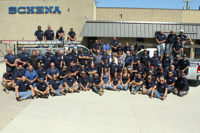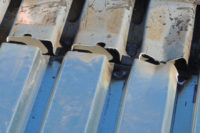
Building Science of Roof Leaks
Roofs must be designed in line with the climate that they will serve in, and in areas that have any appreciable snowfall, that means designing for ice. Although picturesque, a roof dripping with icicles is potentially a sign of a structure in real trouble.The problem begins when snow accumulates on the roof. Heat from the interior rises through the attic space, causing the snow to melt and water flowing toward the eave under the snow pack. This occurs no matter how well the building is insulated. The water refreezes once it reaches the eave because the eave is no longer over heated interior space. This phenomenon continues, forming a large ice dam at the eave with a pool of standing water behind it.
Most sloped roofs are not waterproof. Instead, they perform based on their ability to shed water, and ice dams interfere with that ability. The standing water behind the ice dam easily gets under the roof coverings and drips into the house, usually directly into the cavity of the exterior walls. This water can compromise the performance of the insulation, cause structural deterioration and produce an environment ripe for mold growth. This is how a short-term leak problem can become a chronic liability.
In areas where the snow doesn't fly all that often, the real threat to roof performance is wind and driven rain. Strong winds can lift roof coverings allowing water to enter. Often, the worst areas are near the roof peak on the side of the roof away from the wind direction. As the wind flows over the peak of the roof, the roof coverings on the protected side are moved by the same type of lifting force that works on aircraft wings. In either case the roof is compromised.
Fully Adhered Underlayments are a Key Design Element
For roofs to withstand the normal environmental forces they are exposed to without leaking, it is wise to apply a fully adhered underlayment in areas prone to problems. At one time, the use of a membrane underlayment was considered by many to be optional. However, in today's environment, with roof leaks potentially causing long-term structural and health concerns, these products are absolutely required.All underlayments are not created equal, though. Fortunately, the total cost difference between the premium performers and the economy brands is very small - often less than $50 over the total cost of the roof. This makes premium performance very inexpensive insurance for almost any budget.
The ability of a fully adhered underlayment to keep water out is based on three main characteristics: the product's ability to seal around roofing fasteners, the ability of the product to adhere well to the substrate, and how well the product forms watertight overlaps.
Seal Around the Fastener
The ability to seal around roofing fasteners is the primary performance characteristic to consider when choosing a premium performance underlayment. The expectation is that these products will provide a watertight layer under the roof coverings even though they have thousands of fastener penetrations.All underlayments claim that they seal around fasteners and many will state that they comply with the nail sealability portion of ASTM D1970 as proof. While these are important "must haves," they are not a guarantee that the material will seal well. Fortunately, there are some simple experiments that can be done to discern premium performance.
The simplest test is to push a roofing fastener through the membrane and look at the shank of the nail as it comes through the backside. It should be well coated with adhesive from the membrane indicating a good seal. This test can be made more discriminating by doing it at the manufacturer's low-application-temperature limit since membrane adhesives tend to get harder and less sticky at these temperatures.
Since the ability of the product to seal around fasteners is primarily a function of the quality of the membrane adhesive, another quick test that can be done to determine quality is a low-temperature-flexibility test. This is done by placing a sample of the membrane in a freezer until it is cold and then folding the membrane over, adhesive side up. Premium performance products will most likely bend, while lower performing products will tend to snap.
Adhesion to the Roof Deck and in Overlaps
Adhesion and full contact with the substrate are the other key performance characteristics since it is critical that water cannot travel under the membrane to potential leak points. Premium performing products will tend to generate strong adhesion to the roof deck very quickly at all recommended application temperatures. Once again the differences between products are likely to be most easily seen at the low end of the recommended application temperature range.Adhesion is also important when one sheet overlaps an adjacent sheet, since overlaps are typically the weakest point in any membrane system. In the case of overlaps, though, the quality of the adhesive is not the only factor to consider. The top surface of the membrane is also important because it serves as the "substrate" in an overlap area.
In the broadest terms, underlayments tend to come in two varieties as determined by their surface: granular-surfaced underlayments, which rely on mineral granules to impart slip resistance; and smooth-surfaced membranes, which rely on a smooth but slightly tacky coating to give a safe trafficable surface. Both systems offer good slip resistance but they do differ in their tendencies to make good watertight overlaps.
Watertight overlaps are more easily made with smooth-surfaced membranes than with granular-surfaced products. This is simply due to the fact that granular-surfaced membranes achieve their slip resistance by virtue of the roughness and irregularity of their surface while watertight overlaps are most easily achieved when the surface is smooth and regular.
Underlayments a Second Time
Fully adhered underlayments have been on the market since 1978 but their use grew rather slowly in the early years. Therefore, it is only now that manufacturers are seeing older roofs that had underlayments applied coming due for re-roofing. After many years on the roof, these underlayment materials are for all practical purposes not removable from the roof deck. Contractors are now questioning whether the old membranes will still perform or need to be replaced, whether new membranes can be applied over the old, or how old membranes can be removed.In general, old roofing underlayments will not in themselves provide a watertight barrier under a second roof if they are left intact after their roof coverings have been torn off and replaced. The old membrane is likely to be damaged during the tear-off. However, even if extraordinary care is taken, old fastener penetrations, which no longer have fasteners through them, are unlikely to be watertight despite the fact that membranes do have some ability to self heal.
The simplest method is to apply a new layer of membrane over the old, but once again, the surface of the old membrane must be considered. A new layer of underlayment can be easily applied over an existing underlayment if the surface of the older underlayment is smooth.
If the surface of the old layer of membrane is granular, the choices are less ideal requiring more individual judgment. One of the performance fundamentals is full contact and adhesion to the substrate. If full contact and adhesion to the old membrane cannot be assured, then the old membrane should be removed. Removal may require replacement of the roof deck in affected areas.
When applying a second layer of membrane, the thickness of the second layer will probably telegraph through the new roof coverings. To avoid this, apply an 18-inch-wide strip to the eave, covering half of the old membrane, followed by a full-width membrane strip. In this fashion, there will be two thickness step-downs but each will be no greater than the thickness of a single membrane layer.




